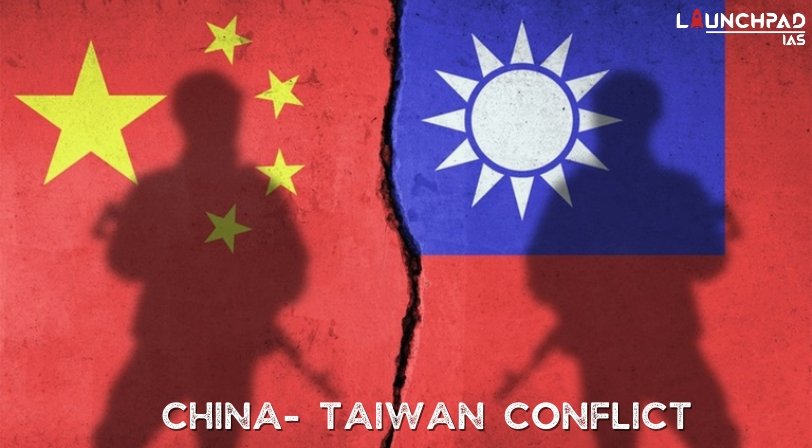About Taiwan
- Taiwan, earlier known as Formosa, a tiny island off the east coast of China, is where Chinese republicans of the Kuomintang government retreated after the 1949 victory of the communists — and it has since continued as the Republic of China.
- The island is located in the East China Sea, to the northeast of Hong Kong, north of the Philippines south of South Korea, and southwest of Japan.
- What happens in and around Taiwan is of deep concern to all of East Asia.

Origin of the conflict
- Taiwan observes October 10 — “double 10” — as its national day; on this day in 1911, sections of the Manchu army rose in rebellion, leading ultimately to the overthrow of the Qing dynasty and the end of 4,000 years of the monarchy.
- The RoC was declared on December 29, 1911, and it found its feet in the 1920s under the leadership of Dr Sun Yat-sen, founder of the Kuomintang (KMT) Party.
- Sun was succeeded by General Chiang Kai-shek, whose actions against the Chinese communists, who were part of an alliance with the KMT, triggered the civil war that ended in victory for the communists and the retreat of Chiang and the KMT to Taiwan.
Consequences
- Since its founding in 1949, the People’s Republic of China (PRC) has believed that Taiwan must be reunified with the mainland, while the RoC has held out as an “independent” country.
- The RoC became the non-communist frontier against China during the Cold War and was the only ‘China’ recognized at the UN until 1971.
- That was when the US inaugurated ties with China through the secret diplomacy of Henry Kissinger, national security adviser to President Richard Nixon.
- The US backs Taiwan’s independence, maintains ties with Taipei, and sells weapons to it — but officially subscribes to PRC’s “One China Policy”, which means there is only one legitimate Chinese government.
- Just 14, mostly very small, countries recognize Taiwan.
The Escalation
- In 1954-55, and 1958, the PRC bombed the Jinmen, Mazu, and Dachen islands under Taiwan’s control, drawing in the US.
- Congress passed the Formosa Resolution, authorizing President Dwight D Eisenhower to defend RoC territory.
- The PRC and ROC then arrived at an arrangement to bomb each other’s garrisons on alternate days – this continued until 1971.
- The most serious encounter was in 1995-96 when China began testing missiles in the seas around Taiwan, triggering the biggest US mobilization in the region since the Vietnam War.
Recent developments in Taiwan
- In 1975, Chiang Kai-shek died, martial law was lifted, and Taiwan got its first democratic reforms.
- Starting from the 1990s, despite the missile crisis, relations between the PRC and RoC improved, and trade ties were established.
- As the British prepared to exit Hong Kong in 1999, the “One China, Two Systems” solution was offered to Taiwan as well, but the Taiwanese rejected it.
- In 2000, Taiwan got its first non-KMT government, when the Taiwanese nationalist Democratic Progressive Party (DPP) won the presidency.
- In 2004, China started drafting an anti-secession law aimed at Taiwan; trade and connectivity, however, continued to improve.
- Today, the two big players in Taiwan’s politics are the DPP and KMT, broadly the parties of the island’s Hakka inhabitants and the minority mainland Chinese respectively.
- The 2016 election of President Tsai marked the onset of a sharp pro-independence phase in Taiwan, and the current tensions with China coincided with her re-election in 2020.
- Taiwan now has massive economic interests, including investments in China, and pro-independence sections worry that this might come in the way of their goals.
- Inversely, the pro-reunification sections of the polity, as well as China, hope that economic dependence and increasing people-to-people contacts will wear out the pro-independence lobbies.
Indian Policy towards Taiwan
- Since 1949, India has accepted the “One China” policy that accepts Taiwan and Tibet as part of China.
- However, India uses the policy to make a diplomatic point, i.e., if India believes in the “One China” policy, China should also believe in a “One India” policy.
- Even though India has stopped mentioning its adherence to the One China policy in joint statements and official documents since 2010, its engagement with Taiwan is still restricted due to the framework of ties with China.
- India and Taiwan do not have formal diplomatic relations but since 1995, both sides have maintained representative offices in each other’s capitals that function as de facto embassies
- The ties focus on commerce, culture, and education.
Related Links: Conflict between North and South Korea


